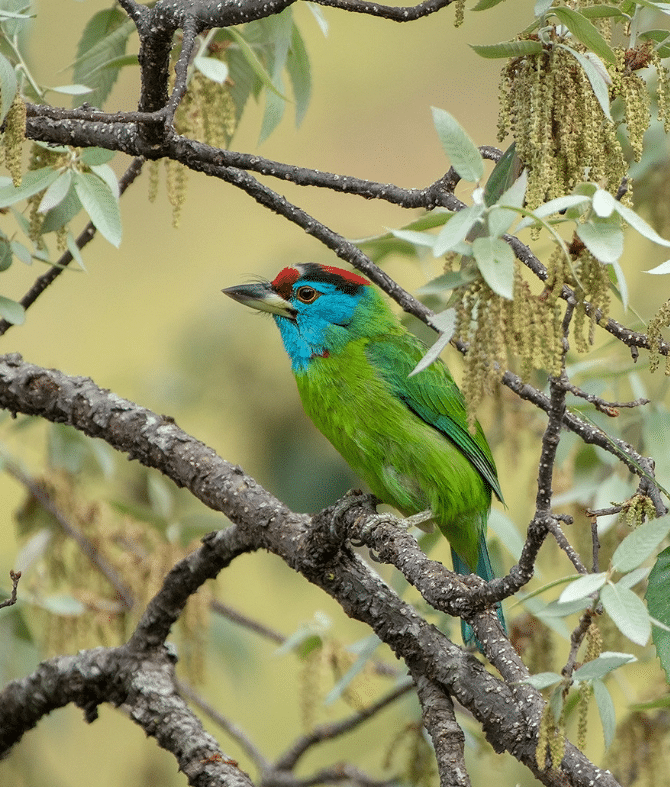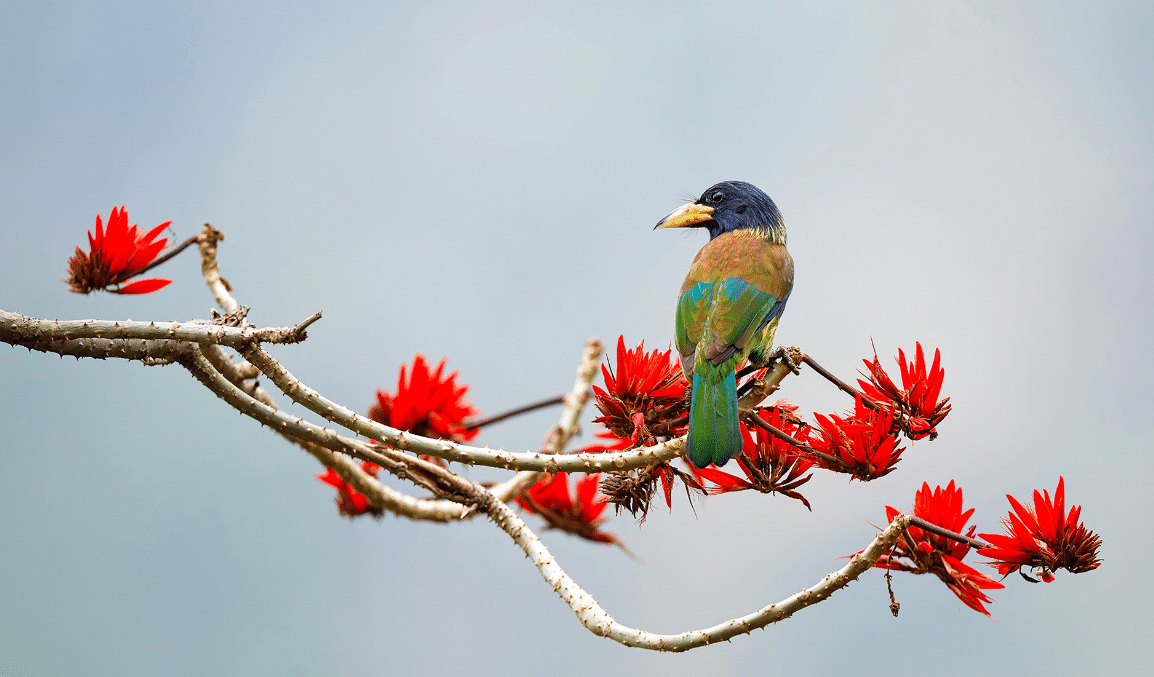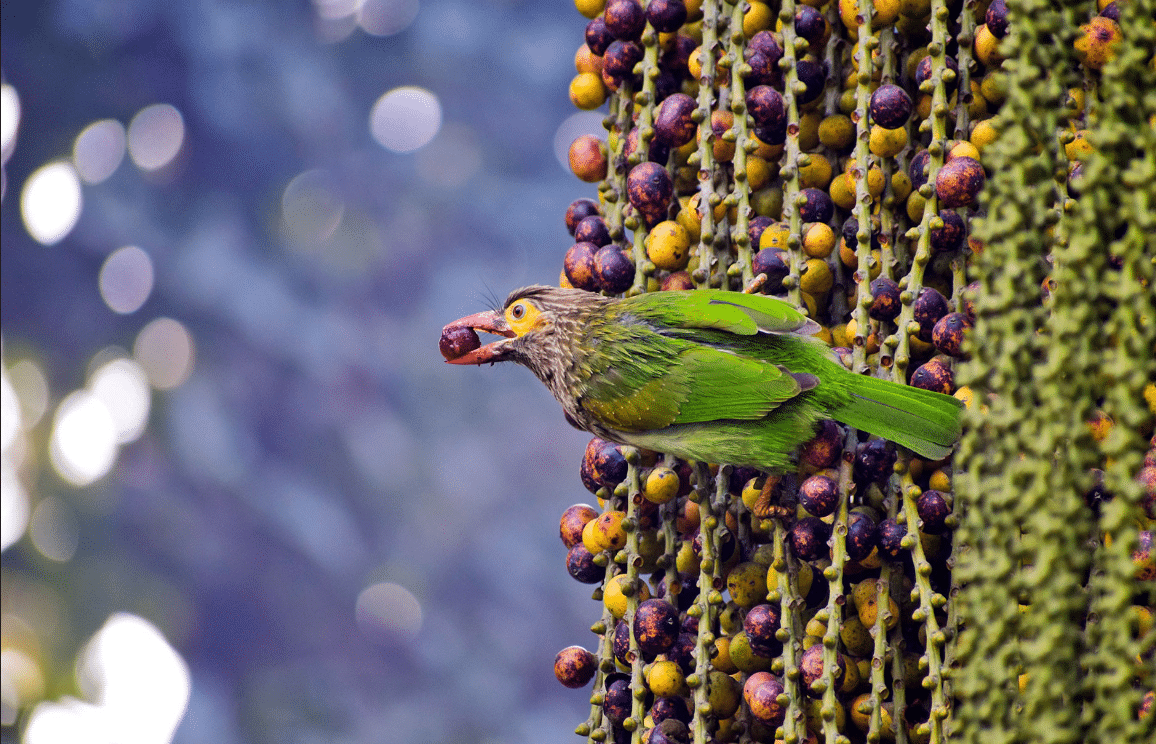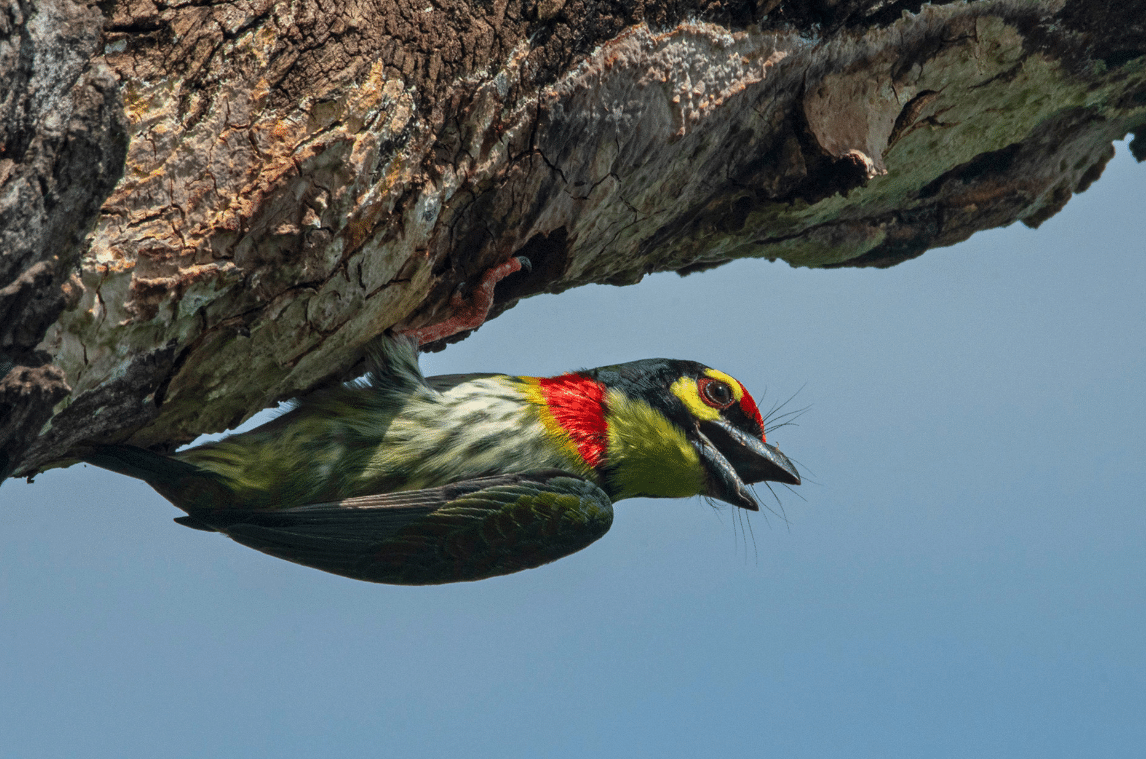Did you know that barbets play a vital role in seed dispersal? While figs are their preferred fruits, they are also known to feed on other berries and wild fruits. Barbets regurgitate seeds and indigestible parts of the fruit, enabling forests to flourish and grow. India is home to nine barbet species. Here’s a quick rundown of these colourful frugivores.
Asian barbets are members of the Megalaimidae family and are small, colourful birds that are frequently found in forests and other green patches. They are mainly divided into two subfamilies; Psilopogon and the Caloramphus. India is home to nine barbet species, all of which belong to the Psilopogon subfamily. From a conservation point of view, these solitary, fruit-eating birds are not threatened and have stable populations in the country. Barbets play a vital role in seed dispersal. While figs are their preferred fruits, they are also known to feed on other berries and wild fruits. Barbets regurgitate seeds and indigestible parts of the fruit, enabling forests to flourish and grow.
A recent first-of-its-kind study by the Wildlife Institute of India (WII) and Nature Conservation Foundation (NCF) showed that the seed dispersal mechanisms of small fruit-eating birds like barbets had a significant impact on both fragments and vast forest areas. The study highlighted the importance of these forest segments in protecting wildlife biodiversity. As more and more forests are converted into land for agriculture and various developmental projects, it will only be a matter of time before we start seeing the impacts on stable bird populations like the barbets. Beyond deforestation, a report by BirdLife International also showed that barbets are among the victims of illegal wild bird trade.
With their bright colours and distinct calls, barbets teach us the importance of preserving our green spaces and protecting our biodiversity. Here is a quick primer on the barbets of India.
Golden-throated Barbet (Psilopogon franklinii)
Striking green plumage, a distinct yellow-orange throat patch, a black bandit-like patch around the eyes and a bright red-yellow rump on the crown – Golden-throated Barbets may be hard to miss if they did not spend most of their time sitting still within tree canopies. These barbets are found in northeast India and nearby countries like Nepal, Bhutan, Thailand, Myanmar and parts of China. They are residents of tropical and subtropical forests, riverine areas, moist deciduous forests and shrublands. Although the breeding season varies depending on where they are, in India they breed between the months of March and August. Like other barbet species, they excavate nests in trees and are territorial about their nesting sites. Golden-throated Barbets feed on berries and fruits.
Blue-eared Barbet (Psilopogon cyanotis)
Blue-eared Barbets can be identified by the multi-coloured mosaic patterns on their head. Predominantly green like all barbets, Blue-eared Barbets have dark blue, light blue, red and yellow patterns on their head. They get their name from the blue ear coverts which are significant in male barbets, while females display duller colours overall. Residents of northeast India, they are also found in Bhutan, Bangladesh, Myanmar and Thailand. They are mainly forest dwellers but are also seen in orchards, gardens and plantations. Blue-eared Barbets breed between January and August and build nests within the hollows of tree trunks. They are arboreal and feed on wild fruits, figs and berries which they forage from the canopies.
Blue-throated Barbet (Psilopogon asiaticus)
Bright green in colour with a distinct blue throat and blue colouration around their eyes and a red-yellow crown – Blue-throated Barbets are a photographer’s delight. Like other barbets, these birds are canopy dwellers. They are found throughout the Himalayas; their range extends from northeast Pakistan all the way to Nepal, southwest China, Myanmar and Thailand. Unlike their counterparts, Blue-throated Barbets are often found along forest edges and in degraded forest lands. Breeding season begins in March and lasts till July. Blue-throated Barbets excavate nests in tree holes, and they feed on flowers, fruits, buds and insects like dragonflies, cicadas and ants.
Great Barbet (Psilopogon virens)
The colourful Great Barbets are the largest among the barbet species. With a striking dark blue head and a yellow bill, Great Barbets display chestnut brown, green and blue plumage along with brown and yellow underparts. They are mainly found in India and its neighbouring countries like Pakistan, Nepal and Bhutan. Their preferred habitats are forests, but they also reside in plantations and orchards. They are shy birds and tend to stay hidden in forest canopies. Breeding season is between February and September when they build nests within tree cavities and holes. Great Barbets feed on fruits, flowers, seeds, buds and occasionally insects.
White-cheeked Barbet (Psilopogon viridis)
As the name suggests, White-cheeked Barbets or Small Green Barbets have white stripes above and below their eyes. These barbets are otherwise predominantly green with a brown neck and head covered in white streaks. Mainly found in the Western Ghats, their range also extends to the southern parts of the Eastern Ghats. They occupy forest land as well as other wooded areas like small parks and gardens. White-cheeked Barbets breed from December to June, and they excavate nests in tree branches. They feed on wild as well as cultivated fruits and are known to cause damage to orchards and fruit plantations. Apart from fruits, they occasionally feed on insects.
Brown-headed Barbet (Psilopogon zeylanicus)
Identified by its green and brown colours, along with a distinct yellow disc around its eyes and a brown-yellow bill, the Brown-headed Barbet is found throughout the Indian subcontinent, Nepal and Sri Lanka. These barbets are forest residents but prefer dry woodlands compared to some of the other species. During the breeding season, which falls between February and October, Brown-headed Barbets form monogamous pairs and nest within tree cavities. They mainly feed on wild fruits and are known to consume cultivated vegetables and fruits as well.
Malabar Barbet (Psilopogon malabaricus)
Malabar Barbets are green barbets that can be identified by their conspicuous heads, which portray a riot of colours like red, black and blue. As the name suggests, they are endemic to the Western Ghats. Also known as Crimson-throated Barbets, they have a distinct black stripe around their eyes and a black crown as well. Apart from the evergreen forests within the ghats, they also reside near wetlands, forest edges and in plantations. Malabar Barbets breed between the months of December and May and they build nests within holes in tree branches. Depending on their location, they feed on wild fruits, coffee berries and various small insects.
Coppersmith Barbet (Psilopogon haemacephalus)
Regular garden visitors, Coppersmith Barbets can be distinguished from other barbet species by the white colouration on their underside, a red patch on the breast and their forehead, and yellow colouration around their eyes. They are found throughout the Indian subcontinent as well as China, Malaysia, Singapore, Thailand and other nearby countries. They can occupy a range of habitats like forests, shrublands, plantations and urban areas as well. Coppersmith Barbets breed almost throughout the year, although this varies depending on their geographic location. In India, their breeding season extends between January and October. Breeding pairs nest in cavities that they excavate in tree trunks. Coppersmith Barbets feed on fruits like guavas, mangoes and figs and also insects like cicadas and termites.
Bright green barbets with streaked grey and brown heads, pink bills and a yellow-orange ring around the eyes, Lineated Barbets are hard to miss as they prefer to seat themselves on bare tree branches. In India, they are found in the foothills of Himachal Pradesh, Uttarakhand, Jharkhand, as well the northeastern states of West Bengal, Sikkim and Arunachal Pradesh. They are also found in neighbouring countries like Myanmar, Thailand, Vietnam and Malaysia. Although Lineated Barbets are forest dwellers, they can reside in gardens and parks. The breeding months are between January and July and often coincide with the regional monsoons. Lineated Barbets mainly excavate nests in dead tree branches or trunks. Like other barbets, they feed on fruits, including those of fishtail palm, neem and figs. They are also known to eat moths, spiders, lizards and various insects.
Hits: 0














